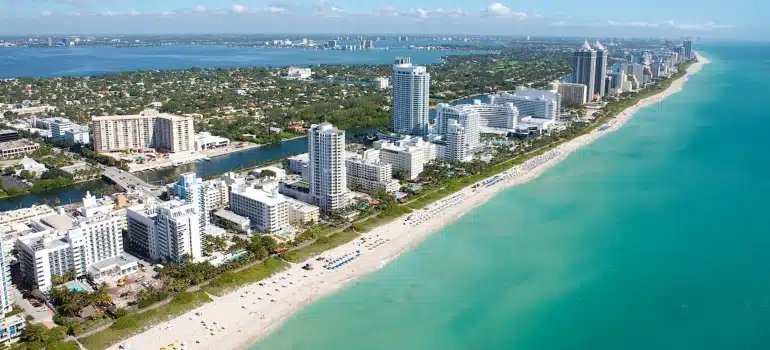Is It Affordable to Live in Wynwood
Wynwood, once a gritty warehouse district, has transformed into one of Miami’s most colorful and energetic neighborhoods. Murals blanket building walls, cafés spill onto the sidewalks, and art galleries attract visitors from all over the world. The cultural scene is thriving, but so is the real estate market. The question is, is it affordable to live in Wynwood? With housing prices, rent, utilities, taxes, and everyday expenses climbing across Miami, understanding Wynwood’s true cost of living is essential for anyone considering a move. If, by the end of reading this article, you still want to relocate to Wynwood, consider hiring Miami movers to help you make an easy transition.
Who is Wynwood for?
One of the things that comes to people’s minds is art! This area is most known for this thing. This is basically a museum of art in the open. There are so many murals across the place that it would take you a lot of time to go and see everything. Also, there is a dedicated Wynwood Art District. A lot of art galleries, murals, and private art collections are located in this area.
But while the creative energy is a huge draw, it’s also important to look at the practical side of life in Wynwood. One of the key factors many people consider before moving with local movers in Florida is the cost of living, which reflects the neighborhood’s growing popularity and transformation.

Current housing market
Buying a home in Wynwood in 2025 is expensive. The median price is about $700,000, with an average of $744 per square foot. This is a small 5.1% drop from last year, but still higher than the Miami metro median of around $650,000.
Condos average about $453,000, making them a slightly more affordable option for those who want the Wynwood lifestyle without paying for a single-family home. The market has slowed compared to the rapid growth of recent years, moving from a hot seller’s market to a more balanced one.
Even so, it is still hard for first-time buyers to afford unless they have large savings or a high income.
Rental prices
If buying isn’t in the cards, renting in Wynwood still requires a healthy budget. In early 2025, one-bedroom apartments typically run between $2,400 and $2,900 per month, while two-bedrooms push well above $3,000.
That’s 40–80% higher than Miami’s overall median rent of $1,590 for a one-bedroom and $2,106 for a two-bedroom.
Typical monthly rents in Wynwood (2025):
- Studio: around $2,000–$2,200
-
One-bedroom: $2,400–$2,900
- Two-bedroom: $3,000+
While newer luxury developments often come with modern amenities like rooftop pools and gyms, the premiums can be steep. For renters seeking more space or updated finishes, the price gap between Wynwood and other Miami neighborhoods can be a deciding factor.
Millennials love Wynwood for its trendsetting atmosphere, but for many in this group, the rent means making financial trade-offs or finding roommates.
Cost of utilities and services
Utility costs in Wynwood tend to mirror those of the greater Miami area. The average monthly electricity bill is about $220, water and trash services add to that, and internet runs close to $70–$80 per month, depending on speed. Air-conditioning is a must for most of the year, which drives electricity bills higher during the summer months. Phone services average nearly $200 per month, although plans vary widely.
On average, residents can expect:
- Electricity: ~$220/month (higher in summer)
- Internet: $70–$80/month
- Phone: ~$197/month
- Water/trash: included in some rentals, $30–$50 if billed separately
Altogether, basic utilities and communication expenses can easily surpass $350 per month for a typical household.
Transportation costs
Wynwood’s central location makes it convenient for public transit users. The free Wynwood trolley connects to other Miami routes, while Metrobus lines and nearby Metrorail and Metromover stations offer broader access to the city.
A monthly transit pass costs around $112, and single rides are $2.25. For drivers, Miami’s average gas price hovers near $3.49 per gallon, and parking in Wynwood can be expensive and competitive, especially during events.
Many residents rely on ride-share services for nights out, which adds to monthly transportation costs but helps avoid parking headaches. For those living and working in Wynwood, being able to walk or bike to work helps cut commuting costs significantly.

Food and dining expenses
Grocery prices in Wynwood are close to Miami’s average, which is about 4% higher than the national level. A gallon of milk is around $4.80, and eggs cost about $3.77 per dozen.
Potatoes can be as much as $5.30 per pound. Eating out is also pricey. Casual meals often cost $20–$25 per person, while upscale restaurants can go over $60 per person.
Examples of everyday costs:
- Coffee: ~$5.90
- Ground beef: ~$7.20/lb
- Movie ticket: ~$16.30
- Haircut: ~$23.60
For those who enjoy Wynwood’s thriving café culture and nightlife, food and beverage spending can become one of the largest monthly expenses.
Taxes and other expenses
One advantage of living in Florida is the absence of a state income tax, which leaves more take-home pay compared to states with higher tax burdens. However, sales tax in Miami-Dade County ranges from 6% to 7.5% depending on surtaxes, and property taxes in Miami average around 1.41% of a home’s assessed value—above the national median of 1.02%.
Florida’s homestead exemption helps offset costs for primary residences, reducing taxable value by up to $50,000 and capping annual assessment increases. Even so, homeowners in Wynwood still face higher annual tax bills due to elevated property values.
Income vs. cost of living
Here’s where the affordability picture becomes clearer. The median household income in Wynwood is just over $31,000, significantly lower than Miami’s overall median of about $59,000.
To live comfortably in Miami, estimates suggest a household income of roughly $77,000 is needed, which is well above what many local residents earn. That gap between income and living expenses is one reason many people need roommates, side income, or higher-paying jobs to make Wynwood work financially. Wages in creative or service industries may not stretch far enough to cover rent, utilities, and other essentials without careful budgeting.

Affordability summary
Wynwood’s affordability depends on income and lifestyle. High earners, remote workers, and entrepreneurs are best positioned to handle its costs.
Florida’s lack of state income tax and Wynwood’s free trolley add appeal, but high housing prices, above-average property taxes, and costly dining can strain budgets. It’s worth considering every expense before hiring movers in Wynwood FL. Some may find better value just outside the neighborhood. Lower housing costs nearby can still offer easy access to Wynwood.
So, Is it affordable to live in Wynwood?
Is it affordable to live in Wynwood? It all comes down to income and priorities. High earners can enjoy the cultural vibe, art, dining, nightlife, and prime Miami location. For others, high housing and rental prices, plus above-average daily costs, make it harder to afford.
Anyone moving here should factor in all expenses—rent or mortgage, utilities, groceries, and transportation. Careful budgeting is key. In some cases, nearby neighborhoods can offer a similar lifestyle at a lower cost.
References:
- https://www.realtor.com/realestateandhomes-search/Wynwood_Miami_FL/overview
- https://www.rentometer.com/average-rents-in-miami-fl
- https://www.pricingvanlines.com/what-is-the-cost-of-living-in-miami-florida
- https://www.reddit.com/r/Miami/comments/yoc7ma/what_do_i_need_to_get_on_the_bus_tomorrow/
- https://www.cbsnews.com/news/why-are-coffee-prices-so-high-inflation/
- https://www.miamidadepa.gov/pa/exemptions_homestead.asp
